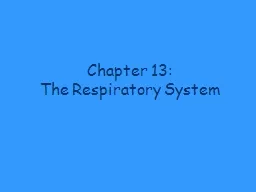

The Respiratory System Organs Nose Pharynx Larynx Trachea Bronchi Lungs Functions Gas exchanges between the blood and environment Occurs in the alveoli of the lungs Passageways to the lungs purify humidify and warm the incoming air ID: 361103
Download Presentation The PPT/PDF document "Chapter 13:" is the property of its rightful owner. Permission is granted to download and print the materials on this web site for personal, non-commercial use only, and to display it on your personal computer provided you do not modify the materials and that you retain all copyright notices contained in the materials. By downloading content from our website, you accept the terms of this agreement.
Slide1
Chapter 13:The Respiratory SystemSlide2
Organs
Nose
Pharynx
LarynxTracheaBronchiLungsSlide3
Functions
Gas exchanges between the blood and
environment
Occurs in the alveoli of the lungsPassageways to the lungs purify, humidify, and warm the incoming airSlide4
The Nose
Only externally visible part of the respiratory system
Air enters the nose through the external nostrils (
nares)Interior of the nose consists of a nasal cavity divided by a nasal septumSlide5
Inside the nasal cavity:
Olfactory
receptors
in mucosa on superior surface for sense of smellRespiratory mucosa everywhere else produces sticky mucus
Moisten air
Trap incoming foreign
particles
Cilia = tiny hair-like structures that move contaminated mucus towards the pharynx where it is swallowed and digested by stomach juices
Projections called conchae on lateral walls
Increase surface area & air turbulenceSlide6
Figure 13.2Slide7
The nasal cavity is separated from the oral cavity by the palate
Anterior
part = hard
palate (bone)Posterior part = soft palate (muscle)Slide8
Paranasal Sinuses
Cavities within bones surrounding the nasal
cavity
Located in the following bones:
Frontal
Sphenoid
Ethmoid
Maxillary
Functions:
Lighten the skull
Act as resonance chambers for speech
Produce mucus Slide9
Pharynx (Throat)
Muscular passage from nasal cavity to larynx
Three
regions from superior to inferior:Nasopharynx
Oropharynx
Laryngopharynx
P
assageways
for air and foodSlide10
Pharyngotympanic tubes
that drain middle ear open
into the
nasopharynxEar infections may follow sore throatTonsils:Pharyngeal tonsil (adenoids) in the
nasopharynx
Palatine tonsils
in
the
oropharynx
Lingual tonsils
at
the base of the tongueSlide11
Figure 13.2Slide12
Larynx (Voice Box)
Function:
Routes
air and food into proper channelsPlays a role in speechStructure:E
ight
rigid hyaline
cartilages
Thyroid cartilage is largest = Adam’s apple
Epiglottis =spoon-shaped
flap of elastic
cartilage
Rises to covers larynx when you swallow so that liquid and food go to the esophagus instead of airway
Vocal folds (aka true vocal cords)
Vibrate with expelled air to create sound
Glottis = opening between vocal cordsSlide13
Anterior View of Larynx
Posterior View of Larynx
http://www.youtube.com/watch?v=QvGYvK6qScESlide14
Upper Respiratory Tract: Larynx
Figure 13.2
http://www.youtube.com/watch?v=9MDn5GgyxyU&feature=relatedSlide15
Trachea (Windpipe)
4 inch long
tube that connects larynx with bronchi
Walls are reinforced with C-shaped hyaline cartilage Lined with ciliated mucosaBeat continuously in the opposite direction of incoming air
Expel mucus loaded with dust and other debris away from lungsSlide16
Trachea (Windpipe)
Figure 13.3aSlide17
Trachea (Windpipe)
Figure 13.3b
The yellow structures are cilia. The orange structures are goblet cells that secrete mucus and have
microvilli
. Slide18
Main (Primary) Bronchi
Formed by division of the trachea
Right
bronchus is wider, shorter, and straighter than leftMore common site for inhaled objects to get stuckSubdivide into smaller and smaller branchesSlide19
Main Bronchi
Figure 13.1Slide20
Lungs
Occupy most of the thoracic cavity
Heart occupies central portion called
mediastinumApex (superior part) is near the clavicle
Base
(inferior part) rests
on the
diaphragm
Each lung is divided into lobes by fissures
Left
lung has two
lobes
Right
lung has three
lobesSlide21
Lungs
Figure 13.4aSlide22
Covering of lungs:
Serosa
covers the outer surface of the lungsPulmonary (visceral) pleura covers the lung surfaceParietal pleura lines the walls of the thoracic cavityPleural fluid fills the area between layers of pleura to allow gliding = less frictionSlide23
Bronchial (Respiratory) Tree Divisions
All but the smallest of these passageways have reinforcing cartilage in their
walls
Largest to smallest:Primary bronchiSecondary bronchi
Tertiary bronchi
Bronchioles
Terminal bronchiolesSlide24Slide25
Respiratory Zone
Structures from largest to smallest:
Respiratory bronchioles
Alveolar ductsAlveolar sacs
Alveoli (air sacs
) – 40x more surface area than skin
Site of gas exchange = alveoli onlySlide26
Respiratory Membrane (
Air-Blood Barrier)
Walls of alveoli are thin
squamous epithelial layer (much thinner than tissue paper!)
Alveolar pores connect neighboring air
sacs incase mucus blocks other paths
Pulmonary capillaries cover external surfaces of
alveoli
O
ne
side of
membrane
is air and
the
other side is blood flowing
past
Also has:
Alveolar macrophages (“dust cells”) that remove bacteria and
debri
Cuboidal
cells that make surfactant (prevent alveoli from collapsing)Slide27
Respiratory Membrane (Air-Blood Barrier)
Figure 13.6 (1 of 2)Slide28
Respiratory Membrane (Air-Blood Barrier)
Figure 13.6 (2 of 2)